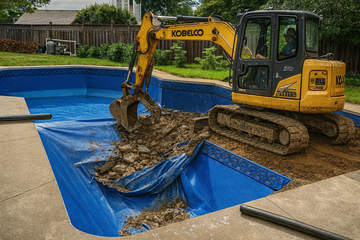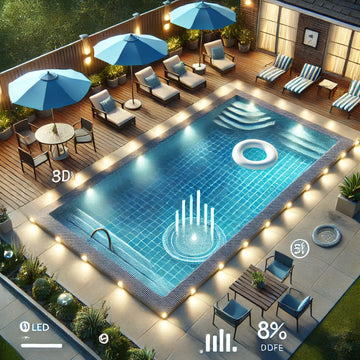COMMON MISTAKES TO AVOID DURING POOL OPENING AND THROUGHOUT THE POOL SEASON
A lot of work goes into pool opening – but it doesn’t end once the pool is open. Your pool requires constant care and attention throughout the pool season to avoid problems from arising in the future. There is plenty of advice on how to properly open your pool, but there are many common mistakes pool owners make which could lead to costly swimming pool repairs.
If you want your pool ready for the first day of swimming weather, you will need a successful pool opening. To save your time and energy, get the help of pool opening professionals.
To get your pool off to a good start this season, avoid these common mistakes pool owners make.
1. ADDING SHOCK DIRECTLY TO POOL WATER
Since shock is a high concentration of chlorine, it can damage vinyl liners if added to the pool directly. The shock granules sink to the bottom of the pool and bleach the liner, causing a damaged and weakened liner prone to leaks.
Instead, carefully dissolve the shock in a bucket of warm water before adding it to your pool. Wear protective eyewear, gloves, and a mask. Also, to avoid splashing add the shock to the water, never the water to chemicals.
2. SHOCK DURING THE DAY
Since the sun evaporates pool water, it will burn off 1 ppm of shock chlorine per hour during the day. This will render your work useless. So only shock your pool at dusk or night.
Also, aim to shock your pool once per week. Remember to NEVER add shock directly to your skimmer if you have an automatic chlorinator. The combination of the chemicals could be explosive.
3. NOT TESTING & BALANCING THE WATER REGULARLY
You should test the pool water regularly—at least once per week. Test the pH balance and chlorine levels with a testing kit. The ideal pH is between 7.2 and 7.6 ppm. The chlorine level should be 1 to 3 ppm.
Consider testing the water monthly for the following:
- Calcium Hardness;
- Cyanuric Acid;
- Salt and TDS (total dissolved solids);
- Copper and Iron;
- Phosphates and nitrates.
If the levels are unbalanced, adjust the chemicals. It’s important to not skip this step as unbalanced water could result in cloudy water, algae growth, and damaging scale formations.
4. NOT ADDING CALCIUM HARDNESS
Add Calcium Hardness to harden your water during pool opening. This will protect the vinyl liner, plaster, concrete, fiberglass, and filtration system.
Keep an eye on the levels throughout the season. The ideal level is between 200 and 250 ppm. A shock treatment with calcium hypochlorite will add a bit of calcium to the water each time you shock it.
5. NOT RUNNING THE FILTER FOR AT LEAST 8 HOURS A DAY
Keep your pool water clean by running your pump and filter for at least 8 hours per day. Also, backwash your filter only when the pressure gauge reads around 10 psi over the normal range of 10 to 15 psi.
6. NOT CLEANING & BRUSHING REGULARLY
Although a pool vacuum helps clean pools, nothing beats brushing it regularly. With a pool brush, you can clean hard-to-reach areas of your pool and prevent dirt from accumulating and algae from growing.
Make sure to remove debris with a net on a daily basis to keep the water clean and avoid clogging the plumbing and equipment. And do NOT use automatic pool cleaners to remove algae as it will spread algae around your pool and could cause clogging. A series of cleaning and treatments are more effective.
Keep these tips in mind to avoid damaging your pool. The last thing you’ll want is swimming pool repairs taking up valuable swim time this summer.




